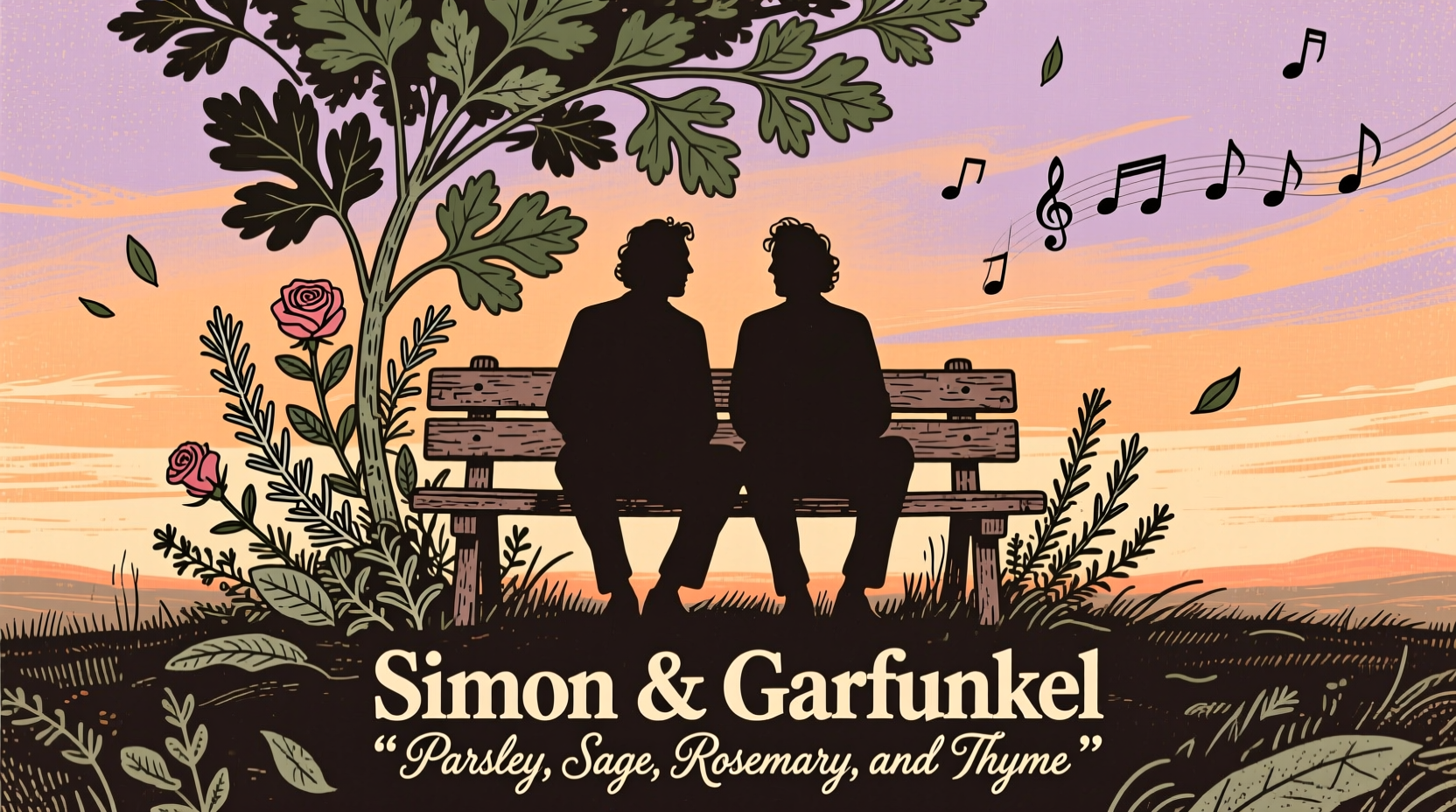Discover why this 1966 masterpiece continues to resonate with listeners more than half a century after its release. Whether you're a lifelong fan or new to Simon & Garfunkel's work, this deep dive reveals the album's historical context, cultural significance, and enduring musical innovations that shaped the folk-rock genre.
The Cultural Moment: Folk Music in 1966
When Simon & Garfunkel entered Columbia Records' Studio B in March 1966, the American music landscape was undergoing dramatic transformation. The British Invasion had peaked, and audiences were increasingly drawn to authentic American sounds. The folk revival movement, spearheaded by artists like Bob Dylan, Joan Baez, and Peter, Paul and Mary, provided the perfect backdrop for Paul Simon's sophisticated songwriting and Art Garfunkel's angelic harmonies.
"Parsley, Sage, Rosemary and Thyme" arrived at a pivotal moment when folk was evolving from protest music toward more personal, introspective songwriting. The album's release preceded the Summer of Love by nearly a year, capturing the transitional period between early 1960s folk purity and the psychedelic experimentation that would dominate 1967.
Decoding the Album Title: More Than Just Herbs
The album's distinctive name draws from the traditional English ballad "Scarborough Fair," which includes the refrain "Parsley, sage, rosemary, and thyme." Simon & Garfunkel would later record their own version for the "The Graduate" soundtrack, but the album title carried deeper significance.
According to Paul Simon's 2011 memoir, the title represented "the four essential herbs of medieval times" that symbolized various virtues: parsley for renewal, sage for wisdom, rosemary for remembrance, and thyme for courage. This symbolic framework perfectly mirrored the album's thematic exploration of love, loss, and the search for meaning in modern life.
| Herb | Medieval Symbolism | Album Theme Connection |
|---|---|---|
| Parsley | Renewal, festivity | "Homeward Bound" - returning home with new perspective |
| Sage | Wisdom, domestic virtue | "The Dangling Man" - moral questioning and reflection |
| Rosemary | Remembrance, fidelity | "Anji" - nostalgic reflection on relationships |
| Thyme | Courage, strength | "The 59th Street Bridge Song" - embracing life's simple joys |
Recording Process: Studio Innovation Meets Folk Tradition
Produced by Bob Johnston (who would later work with Bob Dylan and Johnny Cash), the album represented a significant evolution from Simon & Garfunkel's previous work. Johnston encouraged the duo to experiment with studio techniques while maintaining their acoustic foundation.
"We were finally given the time and resources to craft something special," Art Garfunkel recalled in a 2003 Rolling Stone interview. The sessions featured innovative approaches including:
- Multi-tracking vocals to create their signature harmonies
- Strategic use of reverb to enhance the acoustic instruments
- Layering multiple guitar parts for richer textures
- Experimenting with unconventional song structures
The result was a sound that bridged traditional folk with contemporary production values, setting the template for folk-rock for years to come.
Track-by-Track Significance
While "The Sound of Silence" had become a surprise hit after being added to the album following its initial release, several other tracks established the album's artistic merit:
“Homeward Bound”
Written during Simon's lonely stays at England's Widnes railway station, this song captured the universal feeling of longing for home. Its sophisticated chord progression and vivid imagery made it an instant classic, reaching #5 on the Billboard Hot 100.
“The 59th Street Bridge Song (Feelin' Groovy)”
This deceptively simple tune about taking life easy became one of the duo's most enduring songs. Its minimalist arrangement and carefree message provided perfect counterpoint to the era's growing social tensions.
“The Dangling Man”
Based on Leon Uris's novel about McCarthy-era paranoia, this track showcased Simon's growing political consciousness and narrative songwriting ability. The song's haunting melody and thoughtful lyrics demonstrated the duo's artistic maturity.

Critical Reception Timeline
The album's reception evolved significantly from its initial release to its current status as a classic:
- October 1966: Mixed reviews with Billboard calling it "pleasant but unremarkable"
- January 1967: "The Sound of Silence" reaches #1 after being added to the album, transforming its commercial prospects
- 1968: Included in Rolling Stone's inaugural "500 Greatest Albums" list at #187
- 2003: Ranked #181 on revised Rolling Stone 500 Greatest Albums list
- 2020: Designated "culturally, historically, or aesthetically significant" by the Library of Congress
Enduring Legacy and Modern Relevance
"Parsley, Sage, Rosemary and Thyme" continues to influence contemporary artists across genres. Its sophisticated songwriting, pristine vocal harmonies, and thoughtful production established a template that resonates in today's music landscape.
Modern artists from Fleet Foxes to The Lumineers cite the album as a key influence, particularly appreciating how Simon & Garfunkel balanced poetic lyrics with accessible melodies. The album's themes of searching for meaning, navigating relationships, and finding peace in uncertain times remain strikingly relevant.
For music historians, the album represents a crucial transitional moment when folk music evolved from protest songs toward more personal, introspective work—a shift that would pave the way for singer-songwriters like James Taylor and Carole King.
Why This Album Still Matters
More than five decades after its release, "Parsley, Sage, Rosemary and Thyme" continues to captivate new generations of listeners because it captures something timeless about the human experience. Its songs address universal emotions with poetic precision while maintaining musical sophistication that rewards repeated listening.
The album's enduring appeal lies in its perfect balance of accessibility and depth—simple enough to connect immediately, complex enough to reveal new layers with each listen. In an era of fleeting musical trends, this collection of songs has proven remarkably resilient, speaking to listeners across generations with undiminished power.
What inspired Simon & Garfunkel to choose the album title "Parsley, Sage, Rosemary and Thyme"?
The title comes from the traditional English ballad "Scarborough Fair." Paul Simon explained that each herb represented symbolic meaning: parsley for renewal, sage for wisdom, rosemary for remembrance, and thyme for courage—themes that reflected the album's content.
When was "Parsley, Sage, Rosemary and Thyme" released and how did it perform commercially?
The album was released on October 10, 1966 by Columbia Records. Initially, it peaked at #4 on the Billboard 200 chart, but gained significant momentum after "The Sound of Silence" was added to the tracklist and reached #1 in January 1967, eventually selling over 3 million copies worldwide.
Which songs on "Parsley, Sage, Rosemary and Thyme" became the most successful hits?
"Homeward Bound" reached #5 on the Billboard Hot 100, while "The Sound of Silence" (added after the initial release) became a #1 hit. "The 59th Street Bridge Song (Feelin' Groovy)" also gained significant popularity, particularly after being featured in commercials and films over the decades.
How did "Parsley, Sage, Rosemary and Thyme" influence later music?
The album helped define the folk-rock genre by blending traditional folk instrumentation with contemporary production techniques. Its sophisticated songwriting and vocal harmonies influenced countless artists, from The Beatles' "Rubber Soul" period through modern folk revivalists like Fleet Foxes and The Lumineers.
Why is "Parsley, Sage, Rosemary and Thyme" considered culturally significant?
In 2020, the Library of Congress selected the album for preservation in the National Recording Registry, recognizing it as "culturally, historically, or aesthetically significant." It captures a pivotal moment in American music history when folk was evolving into a more personal, introspective art form that would influence generations of singer-songwriters.











 浙公网安备
33010002000092号
浙公网安备
33010002000092号 浙B2-20120091-4
浙B2-20120091-4